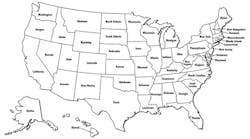RDH eVillage Salary Survey, part 4: Most common hourly rates for hygienists in 39 states
The U.S. Bureau of Labor Statistics is sticking to its 2012 forecasts that more than 60,000 jobs will be added to the dental hygiene workforce during the next seven years, prompting a number of websites to paint a rosy future for job security within the profession.
Forgive the dental hygiene profession for being skeptical, though. Almost three years into the BLS 10-year forecast of “much faster than average” growth in jobs, dental hygienists are still a little cynical.
Nationally, 86% of 1,814 dental hygienists surveyed for the annual RDH eVillage salary survey think jobs are “somewhat” or “very” difficult to find.
Texas seems to be the most indicative of potential job growth in the profession; 24% of Texas dental hygienists said finding a job is “relatively easy.” Other states that said it was relatively easy to find employment are Maryland (19%) and Colorado (16%).
The percentages above are correct. In no state did a majority of dental hygienists say job hunting was easy — not even close to it. The states feeling the greatest pinch due to a shortage of jobs appear to be Missouri, Connecticut, Minnesota, and Michigan.
Skip to dental hygienist job benefits survey results by state >
Dental Hygiene Salaries
The fourth and final installment of the 2014 salary survey does not intend to belabor the perceptions about the job market. The most common hourly rates are reported for each state listed below. In addition, selected comments from hygienists who participate in compensation plans involving commissions, bonuses, or other incentives are listed.
For the record, the most common hourly rates for dental hygienists in the United States are $30, $35, and $40. We mention this because the state reports below often refer to when a state’s pay ray rates are trending below or above those hourly rates
|
Pay Raises
The salary survey also inquired about the frequency of pay raises awarded to dental hygienists. The national percentages are listed below.
Wisconsin wins the “within the last year” category hands-down as 52% received recent raises. Other states that appear to be more fair about raises are Indiana and Maryland.
The worst states for raises appear to be Georgia and Arizona, where almost 30% of dental hygienists reported never receiving a raise.
Our apologies to Arkansas, Delaware, Hawaii, Maine, Montana, North Dakota, Oklahoma, South Dakota, Utah, Vermont, and Wyoming. We simply did not feel we received enough responses from those 11 states to warrant any fair analysis.
About the Author

Mark Hartley
Mark Hartley is the editor of RDH magazine and collaborates with Kristine Hodsdon on many of the articles for RDH eVillage, which also appear on DentistryIQ.com.



